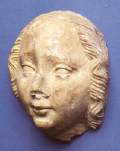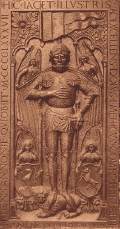
Gothic sculpture continued tasks of sculpture as defined by the Romanesque period, i.e. sculptural decoration, gates and tombs, but it created new genres, too, e.g. ecclesiastical statues, winged altarpieces and heraldic stones.
In the third quarter of 13th century, the prevailing style of the French court influenced architecture, e.g. life-like floral ornaments in sculptural decoration. Classical Gothic ornaments with vine leaves in the Church of Our Lady in Buda date from the 1270s. Ornaments with leaves in the Franciscan Church in Sopron and the Cathedral in Gyulafehérvár both indicate the presence of classical Gothic style. Floral ornaments of Porta speciosa in Pannonhalma are related to the period.
Besides Byzantine traditions, a court variant of the classical Gothic style had a major role in the court of Charles Robert. The altar of Queen Elizabeth, one of the most splendid of its kind, came from Paris.
The style of wood sculptures was defined by classical Gothic traditions of the French, too. Generally it is not known where statues still extant used to stand. This is why the altar of Krig is considered to be unique, its structure is similar to that of Queen Elizabeth's altar. (The statue in the niche was, unfortunately, lost, figures on the wings show great plasticity.)
 Sufferings of Christ (The Crucifix of Mateóc) and maternal affection of Mary were portrayed in order to arouse mystic religiousness and sympathy. The Madonna of Toporc (1340-50) originated from sculptural ornaments of French cathedrals and followed a style of ecclesiastical statues of the 13th century. It was highly popular, especially in the Szepes region. The statue of Madonna of Szlatvin (1370-80) is more slender, and suits the ideal of 14th century court art better.
Sufferings of Christ (The Crucifix of Mateóc) and maternal affection of Mary were portrayed in order to arouse mystic religiousness and sympathy. The Madonna of Toporc (1340-50) originated from sculptural ornaments of French cathedrals and followed a style of ecclesiastical statues of the 13th century. It was highly popular, especially in the Szepes region. The statue of Madonna of Szlatvin (1370-80) is more slender, and suits the ideal of 14th century court art better.
Architectural carvings prove that Gothic floral ornaments survived. They are less life-like, yet they keep recurring (e.g. the first portal of St. Jacob Church in Lőcse).
More sculptural ornaments have survived from the second half of 14th century.
Mary's death, a relief in the Church of Our Lady, Buda, is somewhat less refined, it shows, however, the influence of plastic style of Southern Germany and Austria, so do figures (e.g. female head with crown) in the rood-screen of the Cistercian Abbey, Pilis. or the closely related bishop head from Pécs. (Southern Germany became a major art centre of Central Europe. It was the Parler stone cutter dynasty which improved the architecture of the hall church and developed a new realistic style of sculpture. It is of great significance that similar trends appeared in buildings from the age of Louis the Great, e.g. in Szászsebes and Igló.) Realistic sculptural art which came to Hungary via Southern German and Silesia is present in wood cuttings which decorated altars (the altar in Zsegra and the Madonna in Felsőzugló).
Works of the Kolozsvári brothers represent a solitary peak in sculpture of the 1370s.
The St. Elizabeth Church in Kassa which was damaged in a fire was reconstructed around the 1380s when wood cutters started to work on decorative and highly complicated compositions for the portals.
Around 1400 and after it, buildings were richly decorated with stone-cuttings, they often had figural decorations, consoles with figures and masks, and delicate leaves as decorations. The most significant decision made by Sigismund was that he had first the Castle of Buda then the Castle of Pozsony reconstructed where he employed wood-cutters from Prague and Southern Germany together with masters from France.
The art in the royal court had a decisive contact with artists in the Czech court at the time: masters from Prague worked in the court of Queen Sofia in Pozsony. The elaborate style of missals in Pozsony which were produced at that time was closely related to wood-cuttings from the 15th century, e.g. St. Catherine and Dorothy in Barka, Madonnas in Kis-Lomnic and Dénesfalva, the so-called second Madonna of Toporc and St. Catherine in Podolin. Their delicate figures full of emotions, their aristocratic beauty and drapery in harmonic folds indicate the popularity of "Beautiful Madonnas" in Bohemia. The stylistic marks are sometimes full of drama (Calvary Group in Kassa) or deep pain (Suffering Christ in Transdanubia, or Pieta of Nagyszeben).
Fragments of Christ from Sopron and the Madonna of the Christian Museum in Esztergom are examples of the soft style expressed in stone.
In the early 15th century, a strong realism inspired by Southern Germany appeared and prevailed at the same time as the above mentioned soft style (e.g. powerful statues of buttresses in the Black Church, Brassó, some of which follow the style of Parler in character and drapery, in others they appeared in simplified forms). St. Anthony the Hermit (1440-50), one of the few surviving statues in Transdanubia, is related to this style.
Fragments of statues found in Buda Castle in 1974 represent art in the court of Sigismund.
One of the most impressive works of the 15th century is the red marble fountain erected by King Matthias in Visegrád. Arms of the King and those of countries reigned by him were shaped in the ornamental foliage imitating dry branches which was considered to be particularly elegant at the time. Around 1470, a Western European version of late Gothic style with a realistic-naturalistic character prevailed the court of Matthias, but after he had married Beatrix, Renaissance became more dominant, thus both styles lived in a unique symbiosis. Renaissance ornaments, e.g. gates and tabernacles, more and more often decorated late Gothic churches. This highly peculiar architecture characterises e. g. buildings in Cracow (Poland) and Bártfa.
Gothic Tombs
 In the late 14th century, court portraits and coats-of-arms played a significant role in Europe from which the development of tomb-stone sculpture cannot be separated.
In the late 14th century, court portraits and coats-of-arms played a significant role in Europe from which the development of tomb-stone sculpture cannot be separated.
Louis I erected a gilded tomb made of red marble and white limestone for himself and his father. It had the shape of a canopy covered with lace-like carvings. The tomb was, unfortunately, completely destroyed, only a fragment from Székesfehérvár bears witness to tombs of the age in a delicate style.
From the 1350s onwards, tombs with portraits and figures were erected in honour of dignitaries only. Relief figures were rather sketchy on tombs of bishops in the Cathedral of Gyulafehérvár (e.g. the tomb of Bishop Godofréd, 1355). The tomb of Abbot Sigfrid (†1365) in Pannonhalma is characteristic of ascetic simplicity. The tomb of László Czudar, Abbot of Pannonhalma (†1372) matches the high office with symbols attributed to prelates and plastic drapes.
Compositions on tomb-stones of citizens and the nobility are arranged in such a way that there is always a coat-of-arms of the deceased or a cross in the square for inscription. A series of tomb-stones, works of high standard, was found in the Dominican Church, Buda, which may have come from the same workshop. Of the tomb-stone of Henrik Paucher (1375) only the crest has survived. The name indicates that he may have been appointed foreman at royal buildings. On the tomb-stone of János, a painter (1371), there are three blank coats-of-arms with shields. According to the inscription, the deceased was a painter of the royal court.
The tomb-stone of Stibor (1434) with delicate details was probably produced in a workshop in Buda whose activities were of great significance. The tomb-stone of István Perényi, high steward (1437) in Rudabánya and the flatstone of János Perényi in Tőketerebes both represent a more realistic ornamental style.
Some tomb-stones prepared in honour of prelates bear features related to elements of the realistic style of sculpture in Bavaria and Austria. Lying figures of György Berzeviczy, bishop of Nyitra (†1438) and Dénes Széchy, archbishop of Esztergom (†1465) are connected to this style with sharp-featured faces and splendid ponticals.
Tombs of the three Hunyadis (János, János the Younger. and László) from 1440-70 in Gyulafehérvár reflect a realistic style of Southern German origin. The figure of János Hunyadi represents a new grave type of knights in realistic style. Angels holding coats-of-arms on both sides had become popular by the late 15th century. Battle-scenes (probably side-stones of the tomb of János Hunyadi) with figures indicate space-perception and reflect high demands.
It was probably Provost György Schönberg, who invited the master of Stephanskirche, Vienna, to Pozsony. His taste is best reflected by his tomb prepared in 1470. The portrait-like standing figure in a niche follows realism of Dutch masters.
Tombs of Palatine Imre Szapolyai, (1487), and István Szapolyai (1499) in Szepeshely were Gothic works, several elements (architectural proportions, a rearing horse and a rounded shield with coat-of-arm), however, anticipated Renaissance.
 Sufferings of Christ (The Crucifix of Mateóc) and maternal affection of Mary were portrayed in order to arouse mystic religiousness and sympathy. The Madonna of Toporc (1340-50) originated from sculptural ornaments of French cathedrals and followed a style of ecclesiastical statues of the 13th century. It was highly popular, especially in the Szepes region. The statue of Madonna of Szlatvin (1370-80) is more slender, and suits the ideal of 14th century court art better.
Sufferings of Christ (The Crucifix of Mateóc) and maternal affection of Mary were portrayed in order to arouse mystic religiousness and sympathy. The Madonna of Toporc (1340-50) originated from sculptural ornaments of French cathedrals and followed a style of ecclesiastical statues of the 13th century. It was highly popular, especially in the Szepes region. The statue of Madonna of Szlatvin (1370-80) is more slender, and suits the ideal of 14th century court art better.

 In the late 14th century, court portraits and coats-of-arms played a significant role in Europe from which the development of tomb-stone sculpture cannot be separated.
In the late 14th century, court portraits and coats-of-arms played a significant role in Europe from which the development of tomb-stone sculpture cannot be separated.